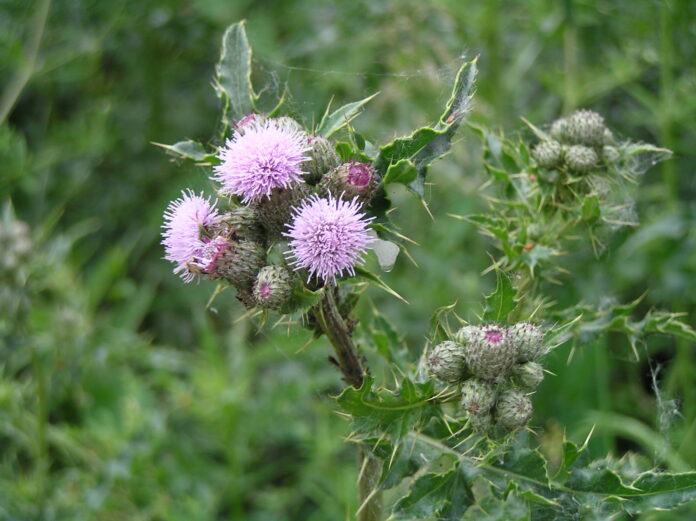BY BLAINE BUG CREW
Welcome back readers to another exciting Weed of the Week! This week’s weed is Canada thistle. This weed is very prevalent in Blaine County. It is found more often down by the river and in wetlands. To learn more about the noxious nature of this weed and how it can be managed with biological control, keep on reading.
Canada thistle is an aggressive, colony-forming perennial weed that reproduces by seed and deep, extensive horizontal roots. Flowering occurs from June through August. The flowers are urn-shaped, purple (sometimes white), and male and female flowers occur on separate plants with heads ranging from 1/2 to 3/4 inch in diameter. Fruits are about 1 ⁄ 8 inch long and brownish with a tuft of hairs at the top. Stems are typically 1 to 4 feet tall with alternate, oblong or lance-shaped leaves divided into spiny-tipped irregular lobes.
Canada thistle is a native of southeastern Eurasia and was introduced to Canada as a contaminant of crop seed in the 18th century. It can commonly be found in gardens, flowerbeds, pastures, cultivated fields, rangelands, forests, and along river banks, ditches and roadsides. Canada thistle can tolerate a wide range of environmental conditions, but requires good light intensity for optimal growth. It is highly competitive with crops and, in heavy concentrations, effectively prevents grazing. A number of accidentally introduced insects attack Canada thistle. Only introduced insects attack Canada thistle; however, only two insects are approved for release—Urophora cardui and Hadroplontus litura.
Hadroplontus litura is a biological control agent that attacks Canada thistle stems and rosettes. Adults feed on rosette leaf foliage in spring, and larvae consume tissue while mining within the shoots. At low densities, larval and adult feeding does not significantly impact the population of Canada thistle directly. Feeding does cause secondary damage, however, as pathogens and other organisms enter the stems of Canada thistle via holes made by exiting larvae. At high densities, feeding the Hadroplontus litura will reduce the vigor of both rosettes and flowering stems to the point of deterioration.
Overwintering weevils emerge from soil litter and feed on leaf and stem tissue in early spring. Eggs are laid in spring within Canada thistle bolting shoots, with hatching larvae mining in the stems and root crown of Canada thistle throughout spring and summer. Multiple larvae (up to 20) can be found in individual stems. Mature larvae tunnel out of the stems, drop to the soil surface, and pupate in the soil. Adults of the new generation emerge in August and overwinter in soil litter. There is one generation per year. The weevil does best in open but moist areas with scattered Canada thistle plants.
It is our mission to continue to monitor this noxious weed and its biological counterpart. By monitoring tanadian thistle, we can see how much work the bug has done to get rid of the plant. We also work to rid your property of this noxious weed in a stable manner without causing harm to any of the surrounding plants. With the continued help of the community, we will be able to better control the hold this plant has on the environment.
If you have a new infestation of Canada thistle, or any other noxious weeds, please call Morgan Baird at (208) 788-5543, ext. 1136.

